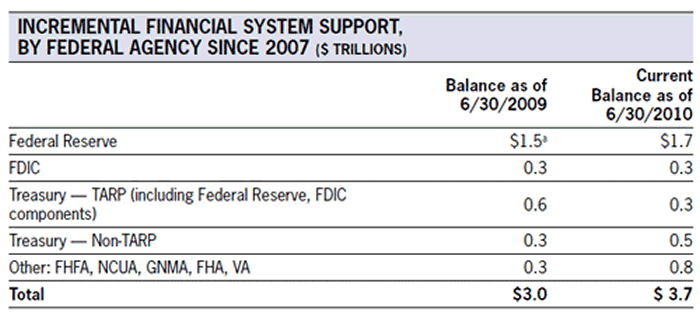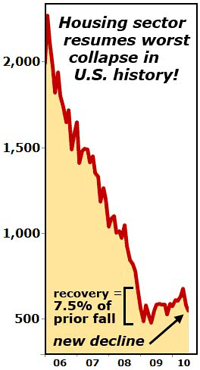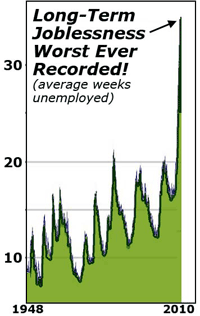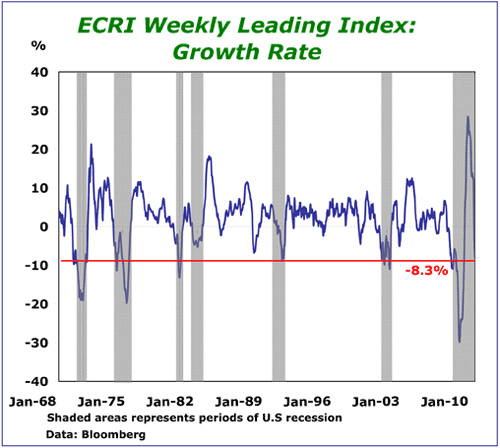Lifted from Market Oracle:
Four Shocking Economic Bombshells Bernanke Did NOT Tell Congress About Last Week
Economics / Great Depression IIJul 26, 2010 - 08:01 AMBy: Martin_D_Weiss

 In his testimony before Congress last week, Ben Bernanke lifted the Fed’s skirt and gave us a glimpse of the disasters now sweeping through the U.S. economy.
In his testimony before Congress last week, Ben Bernanke lifted the Fed’s skirt and gave us a glimpse of the disasters now sweeping through the U.S. economy.
But there are four bombshells he did NOT talk about:
FIRST and foremost, what’s CAUSING the economy to sink? The stock market has not yet crashed. Interest rates have not yet surged. Gasoline prices have not skyrocketed. There has been no recent debt collapse, market shock, or terrorist attack.
So what is the invisible force that’s suddenly gutting the housing market, driving consumer confidence into a sinkhole, and killing the recovery that Washington was so avidly touting just a few months ago?
Bernanke won’t say. But the answer is clear: The recovery had very little substance to begin with. Rather, it was, in essence, a mirage — a dead cat bounce bought and paid for by Washington’s massive bailouts, stimulus programs, and money printing.
Put another way, the recession never really ended. Yes, we saw some growth in GDP. And yes, thanks to that growth, some companies are still reporting better earnings — the news that spurred a rally in the stock market last week. But at the core of the economy, the fires that started the recession are still burning intensely.
SECOND, Bernanke failed to point how that …
The U.S. Housing Market Is Now LOCKED Into a Chronic, Long-Term Depression
Housing starts — the most important measure of the housing industry — is still a disaster zone.
Beginning in January 2006, they suffered their worst plunge in recorded history — from an annual rate of 2.3 million to a meager 477,000 in April 2009. Thus …
In just three years, 79 percent of America’s largest industry, impacting more Americans than any other, was wiped away.
Then, despite a series of government agency programs to shore up the industry … plus $1.25 trillion poured in by the Fed to buy up mortgage-backed securities … plus a big tax credit for new homebuyers, housing starts perked up ever so slightly: They recovered to an annual rate of 612,000 in January of this year.
But this recovery was so small, it retraced just 7.5 percent of the prior fall. In other words,
Even after massive government efforts, and even at the highest point in their recovery this year, the housing industry recouped less than one-tenth of its historic three-year bust from 2006 to 2009.
Worse, the housing industry has now resumed its decline.
The most alarming factor: Widespread “strategic defaults” on home mortgages.
These are defaults by homeowners who can afford to meet their monthly mortgage payments, but have deliberately decided to stop paying.
They realize their home is worth less than they owe on the mortgage — transforming it into a dead asset they’re willing to give up. They know their bank, already overwhelmed with foreclosures, won’t get around to evicting them for as long as two years, allowing them to live in the house cost-free. They also know this tactic can give them tens of thousands of dollars in extra cash. So they’re defaulting en masse and getting away with it.
End result:
- New supplies of foreclosed homes hitting the market as far as the eye can see …
- Bankers who would rather cut their wrists than finance new homes, and …
- A new slump in housing that’s worse than even some pessimists were expecting.
THIRD, despite his now-famous quote that this is “the worst labor market since the Great Depression,” Bernanke failed to reveal that …
Official Government Data GROSSLY Understates the Magnitude of Unemployment
Bernanke did not mention that the percentage of long-term unemployed in America is the worst it’s been since the government began keeping records in 1948. Two facts:
Fact #1: A record 4.39 percent of the work force — or 46.2 percent of the unemployed — have been out of work for 27 weeks or more. That’s DOUBLE the worst level ever recorded and TRIPLE the peak level seen in five of the past six recessions.
Fact #2: On average, America’s unemployed have been out of work for 35.2 weeks, also the highest on record.
Bernanke did not remind Congress that, based on the government’s own broad measure, the true unemployment rate in the U.S. is not 9.5 percent. It’s 16.5 percent — or seven full percentage points more than the figure Mr. Bernanke likes to refer to.
This broader measure includes workers seeking full-time employment, but temporarily settling for lower paying part-time jobs. Plus, it’s supposed to also include “discouraged workers” — those who have given up looking for work because there are no jobs to be found.
Nor did Bernanke confess that, during the Clinton administration, discouraged workers were “redefined” to EXCLUDE those who had been out of work for more than a year — and that definition continues to be used to this day.
That makes absolutely no sense. If they’re out of work for a year, they’re discouraged. But as soon as they’re out of work for a year and one day, it’s suddenly assumed they’re happily going about their life?!
Thus, precisely when economists now recognize that one of the biggest challenges of this Great Recession is long-term unemployment … the Obama administration, both parties in Congress, and all U.S. government agencies continue to exclude the longest term unemployed from every single one of their unemployment statistics.
This could go down in history as one of the greatest deceptions about the true state of U.S. labor markets. And according to John Williams of Shadow Government Statistics, it’s big:
When you add these long-term discouraged workers back into the jobless count, you find that the real unemployment rate in the U.S. is actually 21.6 percent!
FOURTH, Bernanke failed to point out that all this is happening despite …
The Biggest Government Interventions of ALL TIME!
The full scope of the government’s interventions is now official:
In its July 21 Quarterly Report to Congress, the Special Inspector General for the Troubled Asset Relief Program (SIGTARP) tabulates the government’s bailouts, stimulus programs, and money printing escapades since the debt crisis struck in 2007, as follows:

According to SIGTARP, at mid-year 2010,
- The Fed has pumped in $1.7 trillion through its massive purchases of mortgage bonds, Treasury bonds, and agency bonds.
- The FDIC has thrown another $300 billion into the pot, shutting down over 100 banks so far this year.
- The Treasury has pumped in a net of $300 billion in TARP money (even after paybacks), plus another $500 billion in money outside of the TARP program.
- Plus, several other government agencies have chipped in another $800 billion.
These official numbers are actually LARGER than we were estimating. We had the total pegged at $3.5 trillion (not billion), including the 2009 stimulus package.
SIGTARP has it at $3.7 trillion, excluding the stimulus but including a myriad other rescue programs — by the Federal Housing Finance Agency (FHFA), the National Credit Union Administration (NCUA), the Government National Mortgage Association (GNMA), the Federal Housing Administration (FHA), and the Veterans Affair (VA).
But no matter how you count it, some outstanding facts are absolutely self-evident:
FACT: The enormous magnitude of the government’s intervention FAR surpasses anything ever witnessed in the history of humankind.
FACT: It’s not working! Housing is still collapsed. Long-term unemployment is the worst ever recorded. And the recovery, already anemic, is aborting prematurely.
FACT: Most important, it’s winding down! Through mid-2009, the government intervention programs tabulated by SIGTARP were being ramped up at a furious pace — a total of $3 trillion overall.
So over the 12-month period from mid-2008 through mid-2009, we estimate they were running at the average monthly pace of about $160 billion.
But since mid-2009, they have been far slower, running at an average monthly pace of only $58 billion, or just one-third the prior level.
And right now, the pace of new funds injected into the economy through these government rescues are merely a trickle compared to their earlier rate:
- No new stimulus is in the works.
- No new TARP funds are forthcoming.
- The Fed has wrapped up its bond buying splurge.
- And the ONLY significant continuing programs are for housing — the one area where the government has admittedly seen the WORST overall results, according to SIGTARP.
Bottom line:
If you were counting on the government to prevent the second major leg in this great double-dip recession, don’t hold your breath. To the contrary, the primary CAUSE of the second dip is the government’s conspicuous absence from sectors where it was, until now, the biggest mover, shaker, buyer, and financier.
Your ACTION
With this rapidly shifting quicksand, you must NOT be lured by Wall Street’s siren songs. You must not get trapped again in vulnerable stocks, mutual funds, or ETFs. Instead …
- Greatly reduce your exposure to stocks, especially in sectors tied to housing, such as construction, home improvement, consumer appliances, and mortgage finance.
- Move the proceeds to cash and cash equivalent, regardless of low yields.
Good luck and God bless!
Martin
This investment news is brought to you by Money and Markets. Money and Markets is a free daily investment newsletter from Martin D. Weiss and Weiss Research analysts offering the latest investing news and financial insights for the stock market, including tips and advice on investing in gold, energy and oil. Dr. Weiss is a leader in the fields of investing, interest rates, financial safety and economic forecasting. To view archives or subscribe, visit http://www.moneyandmarkets.com.


 In his testimony before Congress last week, Ben Bernanke lifted the Fed’s skirt and gave us a glimpse of the disasters now sweeping through the U.S. economy.
In his testimony before Congress last week, Ben Bernanke lifted the Fed’s skirt and gave us a glimpse of the disasters now sweeping through the U.S. economy.








